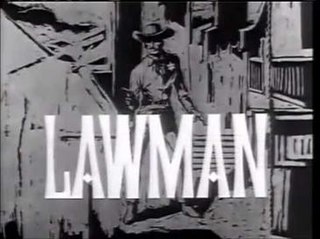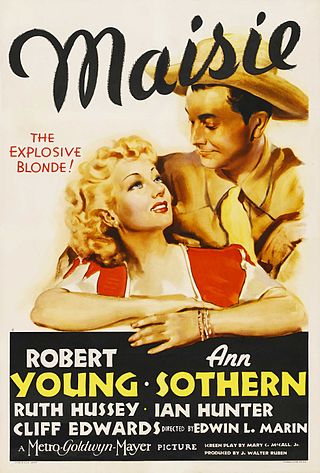
The Lincoln County War was an Old West conflict between rival factions which began in 1878 in Lincoln County, New Mexico Territory, the predecessor of the state of New Mexico, and continued until 1881. The feud became famous because of the participation of William H. Bonney. Other notable participants included Sheriff William J. Brady, cattle rancher John Chisum, lawyer and businessmen Alexander McSween, James Dolan and Lawrence Murphy.

Ann Sothern was an American actress who worked on stage, radio, film, and television, in a career that spanned nearly six decades. Sothern began her career in the late 1920s in bit parts in films. In 1930, she made her Broadway stage debut and soon worked her way up to starring roles. In 1939, MGM cast her as Maisie Ravier, a brash yet lovable Brooklyn showgirl. The character proved to be popular and spawned a successful film series and a network radio series.

Don Ameche was an American actor, comedian and vaudevillian. After playing in college shows, repertory theatre, and vaudeville, he became a major radio star in the early 1930s, which led to the offer of a movie contract from 20th Century Fox in 1935.

Lawman is an American Western television series originally telecast on ABC from 1958 to 1962, starring John Russell as Marshal Dan Troop and Peter Brown as Deputy Marshal Johnny McKay. The series was set in Laramie, Wyoming, during 1879 and the 1880s. Warner Bros. already had several Western series on the air at the time.

On the Riviera is a 1951 Technicolor musical comedy film made by 20th Century Fox. Directed by Walter Lang and produced by Sol C. Siegel from a screenplay by Valentine Davies and Phoebe and Henry Ephron, it is the studio's fourth film based on the 1934 play The Red Cat by Rudolph Lothar and Hans Adler. This version stars Danny Kaye, Gene Tierney and Corinne Calvet, with Marcel Dalio, Henri Letondal and Sig Ruman.

Happy Land is a 1943 film directed by Irving Pichel and starring Don Ameche. A World War II home front drama, it was based on the 1943 novel of the same name by MacKinlay Kantor.

Suppose They Gave a War and Nobody Came is a 1970 American drama-comedy film directed by Hy Averback, produced by Fred Engel, and starring Brian Keith, Don Ameche, Tony Curtis, Ernest Borgnine, Suzanne Pleshette, Ivan Dixon, and Pamela Britton. The plot is a mixture of comic and dramatic elements and concerns the reactions of a number of World War II veterans to the contemporary US Army.

The Ann Sothern Show is an American sitcom starring Ann Sothern that aired on CBS for three seasons from October 6, 1958, to March 30, 1961. Created by Bob Schiller and Bob Weiskopf, the series was the second starring vehicle for Sothern, who had previously starred in Private Secretary, which also aired on CBS from 1953 to 1957.

Maisie is a 1939 American comedy film directed by Edwin L. Marin based on the 1935 novel Dark Dame by Wilson Collison. The rights to the novel were originally purchased by MGM for a Jean Harlow film, but Harlow died in 1937 before a shooting script could be completed. The project was put on hold until 1939, when Ann Sothern was hired to star in the film with Robert Young as leading man.

Ma Barker's Killer Brood is a 1960 American neo noir crime film, released in 1960. The low-budget film was directed by Bill Karn and starred Lurene Tuttle as the title character, Ma Barker.

Fast and Furious is a 1939 American mystery comedy film directed by Busby Berkeley. The film stars Franchot Tone and Ann Sothern as Joel and Garda Sloane, a crime-solving married couple who are also rare book dealers. It is the last of a Metro-Goldwyn-Mayer trilogy, along with Fast Company (1938) and Fast and Loose (1939). However, different actors played the couple each time.

The Story of Alexander Graham Bell is a somewhat fictionalized 1939 biographical film of the famous inventor. It was filmed in black-and-white and released by Twentieth Century-Fox. The film stars Don Ameche as Bell and Loretta Young as Mabel, his wife, who contracted scarlet fever at an early age and became deaf.

Danger – Love at Work is a 1937 American screwball comedy film directed by Otto Preminger and starring Ann Sothern, Jack Haley and Edward Everett Horton. It was produced and distributed by 20th Century Fox. The screenplay by James Edward Grant and Ben Markson focuses on an attorney's frustrating efforts to deal with a wildly eccentric family.

Undercover Maisie is a 1947 American comedy film directed by Harry Beaumont and starring Ann Sothern, Barry Nelson, and Mark Daniels. It was produced by Metro-Goldwyn-Mayer, the final film of the ten film Maisie series starring Ann Sothern as ex-showgirl Maisie Ravier. In this series entry, Maisie Ravier decides to join the Los Angeles police force. The previous film was Up Goes Maisie.

Gun Duel in Durango is a 1957 American Western film directed by Sidney Salkow and starring George Montgomery.

Orphan of the Pecos is a 1937 American Western film produced and directed by Sam Katzman and starring Tom Tyler, Jeanne Martel, Howard Bryant, and Forrest Taylor. Written by Basil Dickey, the film is about a cowboy who is falsely accused of murdering a rancher whose body he discovers. Before the sheriff arrives, he escapes and tries to find evidence to clear his name and help the rancher's daughter save her ranch. The film was released in the United States on December 30, 1937 by Victor Pictures.
The Captain's Kid is a 1936 American comedy film directed by Nick Grinde and written by Tom Reed. The film stars May Robson, Sybil Jason, Guy Kibbee, Jane Bryan, Fred Lawrence and Dick Purcell. The film was released by Warner Bros. on November 14, 1936.

The Transgressors is a crime novel by Jim Thompson, published in 1961. It is one of a very few Thompson novels to feature a traditional love story as a major part of the plot where the lovers have a happy ending together rather than one murdering or betraying the other as is the norm in most of Thompson's novels. As with most of Thompson's novels it takes place in the Southwest (Texas) where Thompson grew up and it leverages Thompson's diverse life experiences in creating the characters and situations in a community dominated by the oil industry.
The Dalton Gang is a 1949 American Western film starring Don "Red" Barry and Julie Adams. It was directed by Ford Beebe.

Captain Peter Rainier was a Royal Navy officer of the eighteenth and nineteenth centuries. Due to the patronage of his uncle, Vice-Admiral Peter Rainier, he was promoted quickly through the ranks so that by the age of twenty he was already a captain. He was given command of the 36-gun frigate HMS Caroline and on 18 October 1806 he fought a successful action in her against the Dutch 36-gun frigate Maria Reijersbergen at Batavia. He captured the treasure ship St Raphael in January 1807 off the Philippines, which had on board £500,000 worth of bullion coin. He left Caroline later in the year and received his next command, the 38-gun frigate HMS Niger, in June 1813. In Niger he participated in the capture of the French 44-gun frigate Ceres off the Cape Verde Islands in January 1814. He left Niger at the end of the Napoleonic Wars and did not receive another command until 1831 when he was given the 120-gun ship of the line HMS Britannia, in which he served in the Mediterranean Fleet until 1835. He died on 13 April of the following year in Southampton after a short illness.


















